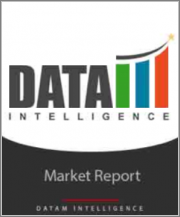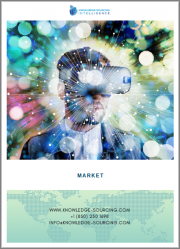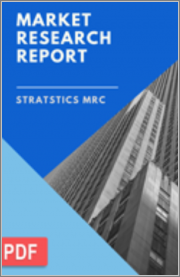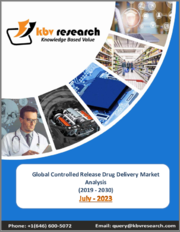
|
시장보고서
상품코드
1316273
세계의 방출 제어형 약물전달 시장(2023-2030년)Global Controlled Release Drug Delivery Market - 2023-2030 |
||||||
시장 개요
세계 방출 제어형 약물전달 시장은 2022년 509억 달러, 2030년에는 1,013억 달러에 달할 것으로 예상되며, 수익성 있는 성장을 보일 것으로 예측됩니다. 세계 방출 제어형 약물전달 시장은 예측 기간(2023-2030년) 동안 9.2%의 CAGR을 보일 것으로 예상됩니다.
방출 제어 시스템은 장기간에 걸쳐 약물의 지속적이고 조절된 방출을 가능하게 합니다. 이러한 조절된 방출은 치료제의 농도를 적절한 범위로 유지하여 치료 효과를 극대화하는 데 도움이 됩니다. 약물 투여 빈도를 줄이고 지속적인 약물 공급을 보장함으로써 환자의 순응도를 높이고 더 나은 치료 결과를 가져올 수 있습니다.
또한, 경쟁이 치열하고 세분화된 산업에서 사업을 영위하고 있는 제약사들은 진화하는 시장 수요에 적극적으로 대응하기 위해 방출 제어형 약물전달 방법 개발에 지속적으로 투자해 왔으며, 그 결과 수요가 크게 증가했습니다.
시장 역학
노령인구와 아동인구 증가로 시장 성장 견인
세계 노인 인구와 소아 인구의 증가는 시장 확대를 촉진하는 주요 요인 중 하나입니다. 노인 인구는 신체적, 정신적, 생물학적 기능이 저하되어 약물 사용에 영향을 미치고 있습니다.
예를 들어, WHO에 따르면, 2050년이면 노인 인구의 80%가 중저소득 국가에 거주하게 될 것이며, 모든 국가는 이러한 인구 통계학적 변화에 대응할 수 있는 보건 및 사회 시스템을 구축하는 것이 큰 과제입니다. 인구의 고령화율은 과거에 비해 상당히 높은 수준입니다.
2020년에는 60세 이상 인구가 5세 미만 청소년보다 많을 것이며, 2015년부터 2050년까지 세계 인구에서 60세 이상이 차지하는 비중은 12%에서 22%로 거의 두 배로 늘어날 것입니다. 결과적으로 노인 인구의 증가는 시장 확대를 촉진할 것입니다.
주요 기업의 노력과 전략 강화도 시장 성장의 원동력
방출 제어형 의약품에 대한 수요 증가에 대응하기 위해 주요 기업들의 활동과 전략이 증가하면서 시장 확대에 힘을 실어줄 것으로 예상됩니다. 예를 들어, 독일 제약회사 Evonik Industries AG는 2020년 10월 흡수 창구가 좁은 소장 상부 부위를 대상으로 경구용 의약품의 장내 흡수를 개선하는 경구용 약물전달 기술인 Eudratec Fasteric을 발표했습니다.
또한, 기존 장비를 사용하여 빠르고 효율적으로 처리할 수 있으며, 다제형, 정제, 캡슐 등 다양한 경구 투여 형태에 대응할 수 있습니다. 앞서 언급한 요인들로 인해 시장이 확대될 것으로 보입니다.
온디맨드 출시 부족이 시장 성장에 걸림돌로 작용
온디맨드 방출 제어형 약물전달 시스템 개발은 기술적으로 어렵습니다. 특정 자극이나 외부 신호에 반응하여 약물 방출을 유발하는 고도의 메커니즘을 통합해야 합니다. 약물 방출 속도와 용량을 정확하게 제어할 수 있는 시스템 설계는 복잡하며, 고도의 재료 기술과 엔지니어링 기술이 필요한 경우가 많습니다.
온디맨드형 방출 제어 시스템 개발에는 특수한 재료, 기술 및 제조 공정이 필요하기 때문에 비용이 많이 들 수 있습니다. 또한, 이러한 시스템의 복잡성은 제조 비용을 증가시킬 수 있으며, 그 결과 널리 사용할 수 있는 경제성과 접근성을 저해할 수 있습니다. 따라서 위의 요인들이 시장 성장을 제한하는 요인이 될 수 있습니다.
COVID-19 영향 분석
COVID-19의 유행은 방출 제어형 약물전달 분야에 긍정적, 부정적 영향을 미치고 있습니다. COVID-19 백신의 긴급한 필요성에 따라 제어 방출 백신 전달 시스템 개발에 큰 중점을 두고 있습니다. 이러한 시스템은 백신의 효능을 높이고, 필요한 투여 횟수를 줄이며, 환자의 순응도를 향상시키는 것을 목표로 합니다.
지속적인 면역반응을 유도하고 잦은 부스터를 필요로 하지 않는 지속형 백신 제제를 개발하기 위해 많은 노력을 기울이고 있습니다. 팬데믹으로 인해 의료 및 제약 연구에 대한 자금과 투자가 증가했습니다. 이로 인해 방출 제어형 약물전달 시스템 개발에 새로운 기회가 생겨났습니다.
러시아-우크라이나 분쟁의 영향 분석
러시아-우크라이나 분쟁은 이 지역의 주요 시장 참여자 수가 적기 때문에 세계 방출 제어형 약물전달 시장에 미치는 영향은 미미할 것으로 추정됩니다. 그러나 원자재 수입 및 수출의 영향은 예측 기간 동안 세계 방출 제어형 약물전달 시장의 성장에 거의 영향을 미치지 않을 것으로 예상됩니다.
목차
제1장 조사 방법과 조사 범위
제2장 정의와 개요
제3장 주요 요약
제4장 시장 역학
- 영향요인
- 성장 촉진요인
- 만성질환 증가
- 주요 기업에 의한 대처와 전략 강화
- 성장 억제요인
- 온디맨드 릴리스의 결여
- 기회
- 의료 인프라에 대한 접근성이 한정되어 있는 신흥 국가
- 영향 분석
- 성장 촉진요인
제5장 산업 분석
- Porter's 5 Force 분석
- 공급망 분석
- 가격 분석
- 규제 분석
제6장 COVID-19 분석
제7장 릴리스 메커니즘별
- 폴리머 기반 약물전달 시스템
- 활성화 조절 약물전달 시스템
- 침투압 약물전달
- 유체역학적 압력 활성화 약물전달
- 증기압식 약물전달
- 기계적 활성화 약물전달
- 화학적 활성화 약물전달 시스템
- pH 활성화 약물전달
- 가수분해 활성화 약물전달
- 효소 활성화 약물전달
제8장 기술별
- Wurster법
- 마이크로 캡슐화
- 코아세르베이션
- 타겟 딜리버리
- 기타
제9장 투여 경로별
- 약물 방출 스텐트
- 눈 임플란트
- 자동 주사기/무바늘 주사기
- 비강 스프레이
- 주입 펌프
- 기타
제10장 지역별
- 북미
- 미국
- 캐나다
- 멕시코
- 유럽
- 독일
- 영국
- 프랑스
- 스페인
- 이탈리아
- 기타 유럽
- 남미
- 브라질
- 아르헨티나
- 기타 남미
- 아시아태평양
- 중국
- 인도
- 일본
- 기타 아시아태평양
- 중동 및 아프리카
- 주요 지역별 역학
제11장 경쟁 상황
- 경쟁 시나리오
- 시장 상황/점유율 분석
- M&A 분석
제12장 기업 개요
- Johnson and Johnson.
- 기업 개요
- 제품 포트폴리오와 개요
- 재무 개요
- 주요 발전
- Coating Place, Inc
- Corium International, Inc
- Depomed, Inc
- Pfizer, Inc
- Biogen
- GlaxoSmithKline
- Novartis
- Orbis Biosciences, Inc.
- Merck and Co.
제13장 부록
ksm 23.08.01Market Overview
The global controlled release drug delivery market reached US$ 50.9 billion in 2022 and is projected to witness lucrative growth by reaching up to US$ 101.3 billion by 2030. The global controlled release drug delivery market is expected to exhibit a CAGR of 9.2% during the forecast period (2023-2030).
Controlled release systems enable the sustained and regulated release of medications over a long period of time. This regulated distribution helps to keep therapeutic medication concentrations within the appropriate range, maximising therapy efficacy. It can increase patient compliance by reducing drug administration frequency and guaranteeing continuous drug supply, resulting in better therapeutic outcomes.
Additionally, pharmaceutical companies, who operate in a fiercely competitive and fragmented industry, have greatly boosted demand as a result of their proactive response to evolving market demands and continued investments in developing controlled-release drug delivery methods.
Market Dynamics
The Increasing Geriatric and Pediatric Population will Drive the Market Growth
The growing geriatric and paediatric population worldwide is one of the primary reasons driving market expansion, owing largely to non-adherence to prescription regimens, which is quite common among these age groups. Geriatric people have impaired physical, mental, and biological functioning, which affect their medication usage.
For instance, according to WHO, all countries have significant challenges in ensuring that their health and social systems are prepared to capitalise on this demographic transformation. By 2050, 80% of the elderly will live in low- and middle-income countries. The population is ageing at a considerably higher rate than in the past.
In 2020, the number of persons aged 60 and more will outnumber youngsters under the age of five. Between 2015 and 2050, the fraction of the global population over the age of 60 will nearly double, from 12% to 22%. As a result, the growing senior population will aid to boost market expansion.
Raising Initiatives And Strategies By the Key Companies also Drive the Market Growth
The increased activities and strategies implemented by key players to deal with the growing demand for controlled release medicine delivery are also predicted to fuel market expansion. For instance, in October 2020, Evonik Industries AG, a German pharmaceutical company, has introduced Eudratec Fasteric, an oral drug delivery technology that improves intestinal absorption for oral drug products that target sites in the upper small intestine with a narrow absorption window.
Furthermore, it can be processed rapidly and efficiently using conventional instruments and is compatible with a wide range of oral dose forms, including multiarticulate, tablets, and capsules. The market will expand as a result of the aforementioned factors.
Lack of On-Demand Release will Hamper the Market Growth
Developing on-demand controlled release drug delivery systems is technically challenging. It requires the integration of sophisticated mechanisms to trigger drug release in response to specific stimuli or external signals. Designing such systems with precise control over drug release rates and dosages is complex and often requires advanced materials and engineering techniques.
Developing on-demand controlled release systems can be costly due to the need for specialized materials, technologies, and manufacturing processes. Additionally, the complexity of these systems may increase the production costs, making them less affordable and accessible for widespread use. Thus, above factors will restrict the market growth.
COVID-19 Impact Analysis
The COVID-19 pandemic has had both positive and negative impacts on the field of controlled release drug delivery. With the urgent need for COVID-19 vaccines, there has been a significant emphasis on developing controlled release vaccine delivery systems. These systems aim to enhance vaccine efficacy, reduce the number of doses required, and improve patient compliance.
Efforts have been made to develop long-acting vaccine formulations that provide sustained immune response and eliminate the need for frequent boosters. The pandemic has led to increased funding and investment in healthcare and pharmaceutical research. This has created new opportunities for the development of controlled release drug delivery systems.
Russia-Ukraine War Impact Analysis
The Russia-Ukraine conflict is estimated to have a moderate impact on the global controlled release drug delivery market, owing to the low number of key market players in this region. However, the impact of the import and export of raw materials is expected to have little influence over the global controlled release drug delivery market growth over the forecast period.
Segment Analysis
The global controlled release drug delivery market is segmented based on release mechanism, technology, route of administration and region.
Auto-injectors/Needle-free injectors from Route of Administration Segment Aaccounts for 30.7% of Market Share Owing to Rising Novel Product Launches
During the projection period, targeted drug delivery is expected to dominate the market. This is mainly due to expanding demand, as well as a growing geriatric and paediatric population. For instance, In 2021, there were about 26.2 million children between the ages of 12 and 17 years old living in the United States. On the other hand, there were about 22.9 million children between the ages of zero and five years old in the country.
Additionally, when compared to typical delivery methods, targeted delivery systems achieve a longer therapeutic effect by delivering medications at the target site at predetermined drug release kinetics. Furthermore, the increasing number of product launches as a result of the increased benefits afforded by targeted delivery are likely to support the segment's growth.
Geographical Analysis
Europe Accounted for Approximately 27.4% of the Market Share
Due to increased R&D efforts and the presence of large pharmaceutical companies in the region. With an increase in patients suffering from chronic diseases such as cancer, diabetes, and COPD, the regional market is expected to grow steadily in the next years.
For instance, according to EUROSTAT, In 2020, cancer was the second highest cause of death in the EU, accounting for 1.2 million deaths, or 23.0% of all deaths in the EU. Cancer claimed a greater share of male mortality (24.9%) than female deaths (20.0%). As a result, the previously mentioned factors will dominate market growth.
Competitive Landscape
The major global players in the controlled release drug delivery market include: Johnson and Johnson, Coating Place, Inc, Corium International, Inc, Depomed, Inc, Pfizer, Inc, Biogen, GlaxoSmithKline, Novartis, Orbis Biosciences, Inc., Merck and Co among others.
Why Purchase the Report?
- To visualize the global controlled release drug delivery market segmentation based on release mechanism, technology, route of administration and region,as well as understandkey commercial assets and players.
- Identify commercial opportunities by analyzing trends and co-development.
- Excel data sheet with numerous data points of controlled release drug delivery market-level with all segments.
- PDF report consists of a comprehensiveanalysis after exhaustive qualitative interviews and an in-depth study.
- Product mapping available asexcelconsisting of key products of all the major players.
The global controlled release drug delivery market report would provide approximately 53 tables, 54 figures and 195 Pages.
Target Audience 2023
- Manufacturers/ Buyers
- Industry Investors/Investment Bankers
- Research Professionals
- Emerging Companies
Table of Contents
1. Methodology and Scope
- 1.1. Research Methodology
- 1.2. Research Objective and Scope of the Report
2. Definition and Overview
3. Executive Summary
- 3.1. Snippet by Release Mechanism
- 3.2. Snippet by Technology
- 3.3. Snippet by Route of Administration
- 3.4. Snippet by Region
4. Dynamics
- 4.1. Impacting Factors
- 4.1.1. Drivers
- 4.1.1.1. Increase in prevalence of chronic diseases
- 4.1.1.2. Raising initiatives and strategies by the key companies
- 4.1.2. Restraints
- 4.1.2.1. Lack of On-Demand Release
- 4.1.3. Opportunity
- 4.1.3.1. Developing countries with limited access to healthcare infrastructure
- 4.1.4. Impact Analysis
- 4.1.1. Drivers
5. Industry Analysis
- 5.1. Porter's 5 Forces Analysis
- 5.2. Supply Chain Analysis
- 5.3. Pricing Analysis
- 5.4. Regulatory Analysis
6. COVID-19 Analysis
- 6.1. Analysis of COVID-19
- 6.1.1. Scenario Before COVID-19
- 6.1.2. Scenario During COVID-19
- 6.1.3. Scenario Post COVID-19
- 6.2. Pricing Dynamics Amid COVID-19
- 6.3. Demand-Supply Spectrum
- 6.4. Government Initiatives Related to the Market During Pandemic
- 6.5. Manufacturers Strategic Initiatives
- 6.6. Conclusion
7. By Release Mechanism
- 7.1. Introduction
- 7.1.1. Market Size Analysis and Y-o-Y Growth Analysis (%), By Release Mechanism
- 7.1.2. Market Attractiveness Index, By Release Mechanism
- 7.2. Polymer-based drug delivery system*
- 7.2.1. Introduction
- 7.2.2. Market Size Analysis and Y-o-Y Growth Analysis (%)
- 7.3. Activation modulated drug delivery system
- 7.3.1. Osmotic pressure activated drug delivery
- 7.3.2. Hydrodynamic pressure activated drug delivery
- 7.3.3. Vapor pressure activated drug delivery
- 7.3.4. Mechanically activated drug delivery
- 7.4. Chemically activated drug delivery system
- 7.4.1. pH activated drug delivery
- 7.4.2. Hydrolysis activated drug delivery
- 7.4.3. Enzyme activated drug delivery
8. ByTechnology
- 8.1. Introduction
- 8.1.1. Market Size Analysis and Y-o-Y Growth Analysis (%), By Technology
- 8.1.2. Market Attractiveness Index, By Technology
- 8.2. Wurster technique*
- 8.2.1. Introduction
- 8.2.2. Market Size Analysis and Y-o-Y Growth Analysis (%)
- 8.3. Micro encapsulation
- 8.4. Coacervation
- 8.5. Targeted delivery
- 8.6. Others
9. By Route of Administration
- 9.1. Introduction
- 9.1.1. Market Size Analysis and Y-o-Y Growth Analysis (%), By Route of Administration
- 9.1.2. Market Attractiveness Index, By Route of Administration
- 9.2. Drug-eluting stents*
- 9.2.1. Introduction
- 9.2.2. Market Size Analysis and Y-o-Y Growth Analysis (%)
- 9.3. Ocular implants
- 9.4. Auto-injectors/ Needle-free injectors
- 9.5. Nasal sprays
- 9.6. Infusion pumps
- 9.7. Others
10. By Region
- 10.1. Introduction
- 10.1.1. Market Size Analysis and Y-o-Y Growth Analysis (%), By Region
- 10.1.2. Market Attractiveness Index, By Region
- 10.2. North America
- 10.2.1. Introduction
- 10.2.2. Key Region-Specific Dynamics
- 10.2.3. Market Size Analysis and Y-o-Y Growth Analysis (%), By Release Mechanism
- 10.2.4. Market Size Analysis and Y-o-Y Growth Analysis (%), By Technology
- 10.2.5. Market Size Analysis and Y-o-Y Growth Analysis (%), By Route of Administration
- 10.2.6. Market Size Analysis and Y-o-Y Growth Analysis (%), By Country
- 10.2.6.1. U.S.
- 10.2.6.2. Canada
- 10.2.6.3. Mexico
- 10.3. Europe
- 10.3.1. Introduction
- 10.3.2. Key Region-Specific Dynamics
- 10.3.3. Market Size Analysis and Y-o-Y Growth Analysis (%), By Release Mechanism
- 10.3.4. Market Size Analysis and Y-o-Y Growth Analysis (%), By Technology
- 10.3.5. Market Size Analysis and Y-o-Y Growth Analysis (%), By Route of Administration
- 10.3.6. Market Size Analysis and Y-o-Y Growth Analysis (%), By Country
- 10.3.6.1. Germany
- 10.3.6.2. U.K.
- 10.3.6.3. France
- 10.3.6.4. Spain
- 10.3.6.5. Italy
- 10.3.6.6. Rest of Europe
- 10.4. South America
- 10.4.1. Introduction
- 10.4.2. Key Region-Specific Dynamics
- 10.4.3. Market Size Analysis and Y-o-Y Growth Analysis (%), By Release Mechanism
- 10.4.4. Market Size Analysis and Y-o-Y Growth Analysis (%), By Technology
- 10.4.5. Market Size Analysis and Y-o-Y Growth Analysis (%), By Route of Administration
- 10.4.6. Market Size Analysis and Y-o-Y Growth Analysis (%), By Country
- 10.4.6.1. Brazil
- 10.4.6.2. Argentina
- 10.4.6.3. Rest of South America
- 10.5. Asia-Pacific
- 10.5.1. Introduction
- 10.5.2. Key Region-Specific Dynamics
- 10.5.3. Market Size Analysis and Y-o-Y Growth Analysis (%), By Release Mechanism
- 10.5.4. Market Size Analysis and Y-o-Y Growth Analysis (%), By Technology
- 10.5.5. Market Size Analysis and Y-o-Y Growth Analysis (%), By Route of Administration
- 10.5.6. Market Size Analysis and Y-o-Y Growth Analysis (%), By Country
- 10.5.6.1. China
- 10.5.6.2. India
- 10.5.6.3. Japan
Australia
- 10.5.6.4. Rest of Asia-Pacific
- 10.6. Middle East and Africa
- 10.6.1. Introduction
- 10.6.2. Key Region-Specific Dynamics
- 10.6.3. Market Size Analysis and Y-o-Y Growth Analysis (%), By Release Mechanism
- 10.6.4. Market Size Analysis and Y-o-Y Growth Analysis (%), By Technology
- 10.6.5. Market Size Analysis and Y-o-Y Growth Analysis (%), By Route of Administration
11. Competitive Landscape
- 11.1. Competitive Scenario
- 11.2. Market Positioning/Share Analysis
- 11.3. Mergers and Acquisitions Analysis
12. Company Profiles
- 12.1. Johnson and Johnson.*
- 12.1.1. Company Overview
- 12.1.2. ProductPortfolio and Description
- 12.1.3. Financial Overview
- 12.1.4. Key Developments
- 12.2. Coating Place, Inc
- 12.3. Corium International, Inc
- 12.4. Depomed, Inc
- 12.5. Pfizer, Inc
- 12.6. Biogen
- 12.7. GlaxoSmithKline
- 12.8. Novartis
- 12.9. Orbis Biosciences, Inc.
- 12.10. Merck and Co.
LIST NOT EXHAUSTIVE
13. Appendix
- 13.1. About Us and Services
- 13.2. Contact Us


















